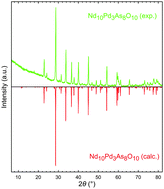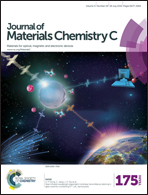Palladium pnictide oxides Nd10Pd3As8O10 and Sm10Pd3As8O10 – low temperature structural phase transition and physical properties
Abstract
New quaternary palladium arsenide oxides Nd10Pd3As8O10 and Sm10Pd3As8O10 were synthesized from the rare earth (RE) elements, appropriate rare earth oxides, arsenic and palladium sponge at maximum annealing temperatures of 1223 K. The structure of the neodymium compound was refined from X-ray single crystal diffractometer data at different temperatures. The samarium compound was found to be isotypic on the basis of Guinier powder diffraction. Both compounds are isotypic with Nd10Au3As8O10 and consist of stacked, formal polycationic [RE10O10]10+ and polyanionic [Pd3(As2)4]10− layers. In contrast to the well-known, tetrahedrally coordinated rare earth oxide layers with basically ionic bonding, the palladium arsenide layers exhibit rather covalent character, which is underlined by XPS data. Electrical resistivity measurements indicate semiconducting properties for Nd10Pd3As8O10 and additionally show an anomaly at approximately 160 K, which results from a structural phase transition, clarified by X-ray single crystal diffractometer data. The phase transition originates from out of plane distortions of the palladium atoms, which show structural order around 160 K. Specific heat measurements and temperature dependent magnetic susceptibility data (including low field measurements) do not show any corresponding anomaly, referring to a very small structural change, which mainly effects electrical conductivity in the present palladium arsenide substructure. Nd10Pd3As8O10 exhibits Curie–Weiss paramagnetism and shows no magnetic order down to 2.5 K. Electronic band structure calculations predict a metallic state – probably due to the very small gap – and confirm the covalent character of the [Pd3As8] layer.


 Please wait while we load your content...
Please wait while we load your content...